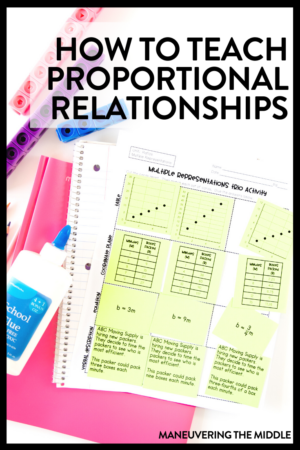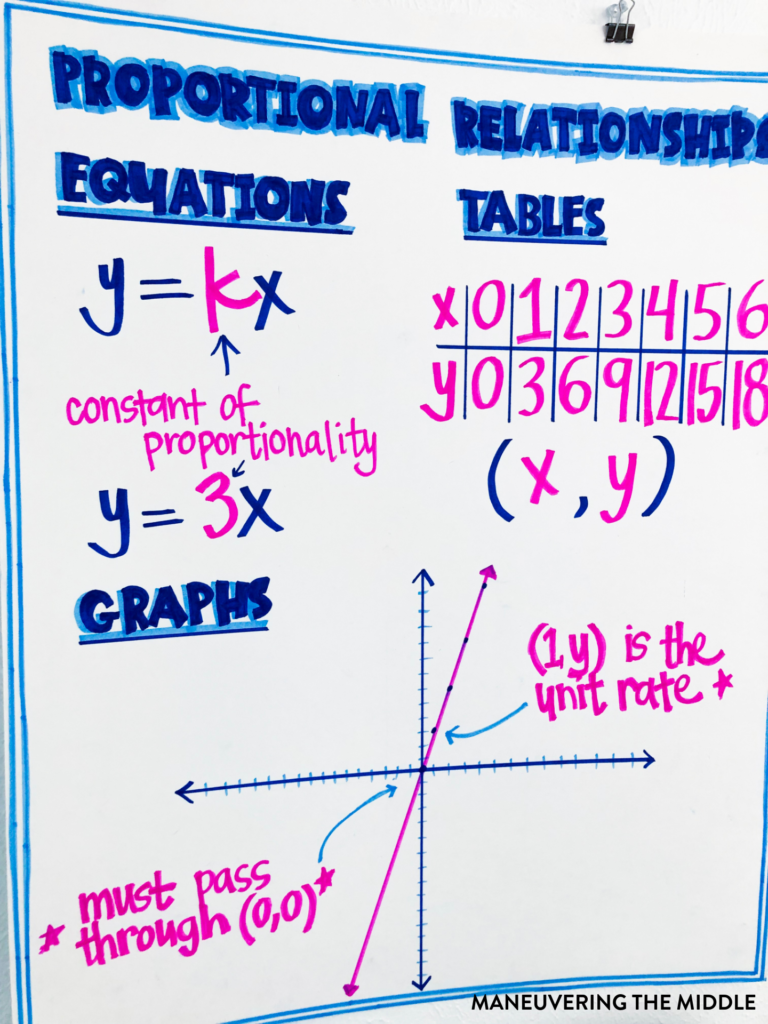Representing Proportional Relationships With Equations


Proportional relationships are ingrained in our everyday. While most students pick up on the process to solve proportions fairly quickly, in that location is then much foundational conceptual knowledge that nosotros practice not want to skip over.
Today, I am sharing how proportional relationships become far across only solving for a missing number and how to prepare a foundation for success in Algebra. Here are all the ways a seventh grader is expected to know and understand proportional relationships:
7.RP.ii Recognize and stand for proportional relationships between quantities.
- 7.RP.2A Decide whether two quantities are in a proportional relationship , e.g., past testing for equivalent ratios in a table or graphing on a coordinate plane
- 7.RP.2B Identify the abiding of proportionality (unit rate) in tables, graphs, equations, diagrams, and verbal descriptions of proportions.
- 7.RP.2C Stand for proportional relationships by equations.
- 7.RP.second Explicate what a point (x, y) on the graph of a proportional relationship means in terms of the situation, with special attending to the points (0, 0) and (i, r), where r is the unit rate.
Visual Representations
These standards are heavily weighted with visual representations, including tables, graphs on the coordinate plane, and diagrams. Some students volition have been exposed to these multiple representations in 6th form with standard vi.RP.3 and equivalent ratios . The goal is for students to fluently connect the table, equation, graph, exact description, and even diagram together. When given ane slice of information, students should be able to represent that same information in multiple ways. Students who can exercise this will take a firm foundation for 8th course math and Algebra 1.
Ideas for Teaching Proportional Relationships
There are tons of great ideas and activities out there, but below are a few of my favorite "tried and true." They are all piece of cake to contain and provide scaffolding for students who struggle in the math classroom.
1. Multiple Representations Graphic Organizer
Some students need to come across everything together, and that is where this multiple representations graphic organizer comes in handy. It is the perfect size for students to show their work. I actually like how the components stay the same, but the given information changes.

These are perfect for introducing the diverse visual representations, merely it also can be reused in a clear pocket to use in tutoring or in math intervention. One time students are familiar with the graphic organizer, I would fifty-fifty give students butcher newspaper and various pieces of information. So, they would use markers to represent the remaining data. This is a quick informal cess idea or can even function as partner work for a Friday.
2. Highlight the Unit Rate/Constant of Proportionality
A quick trick to assist students see all the connections is to use a highlighter! Model and accept students highlight the unit rate/constant of proportionality within the different representations. This is perfect for representing k in the equation and in the table or meeting 7.RP.2d by labeling (1, r) on the graph.
three. Emphasize Vocabulary
Hopefully, students are familiar with the term "unit of measurement charge per unit" and how to detect it. Constant of proportionality sounds so cumbersome and challenging . Unit rate is ofttimes emphasized when we are talking near unit price (price per ounce, etc), and so I call back students have trouble seeing a graph or a tabular array and also using the phrase "unit of measurement rate." Either manner, students need to be familiar with the circumlocution and sympathise what a question is asking. Here is a more detailed explanation for why they are the same.
Common Misconceptions
- A human relationship is not proportional unless (0,0) is visible in the table or graph
- Dividing x/y to observe g
- Full general confusion nearly chiliad
- General disconnect between g and proportions
- Proportional relationships simply involve positive numbers
- Mixing upwards x and y on the table, when it is non given
Ballast Chart Ideas
Anchor charts are fabled ways to showcase the content in a visual mode for students to reference. They tin can easily be created before the lesson or as you are teaching, depending on the content. The visual representations of proportional relationships are perfect for anchor charts.

Ideas for Struggling Students
- Practice finding different points in the proportion that aren't listed on a table.
- Begin with the equation and apply and input-output table to create a table.
- Use a four corners graphic organizer.
- Match multiple representations.
- Practice graphing with four quadrants (from 6th class).
Hopefully, this gives you some ideas for teaching proportions or fifty-fifty insight as to what cognition your students are coming with. I would love to hear other great activities or ideas you have used! Experience free to share in the comments.

Check out some of our other math concepts posts: percents | ratios | integers
What concept would you similar to hear more from us virtually?

Reader Interactions
Representing Proportional Relationships With Equations,
Source: https://www.maneuveringthemiddle.com/how-to-teach-proportional-relationships/
Posted by: alstonculam1943.blogspot.com


0 Response to "Representing Proportional Relationships With Equations"
Post a Comment